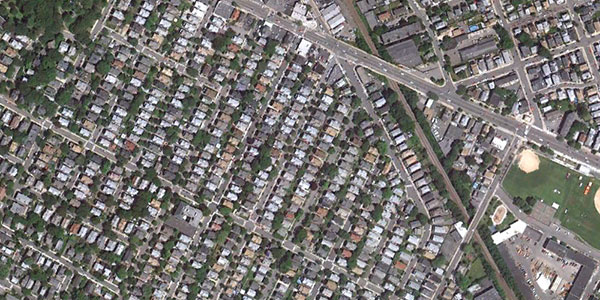By Katrina Marland
Across this blog and throughout the American Forests website, you can find a wealth of information about the various and sundry benefits that trees can provide — from the physical (cleaner air) to the economic (higher property value). Trees can also tell us a lot of things, whether it is the inconsequential cliché etched in their bark that “Jimmy loves Sally” or the more important (at least scientifically) history of a region’s climate. And, as pointed out recently by another blogger, trees can also tell us how wealthy a neighborhood is — from space.
In his blog, Per Square Mile, Tim DeChant discusses a 2008 study published in Landscape and Urban Planning that worked to better understand the relationship between income and tree cover in U.S. cities. What it found is that even small increases in income would increase an area’s tree cover. Similarly, even small decreases in income correlate to a decrease in tree cover. To put it simply: more money equals more trees. In his blog, Tim illustrated this point through satellite photos of high- and low-income neighborhoods. Sadly, you don’t have to look hard to see which ones are greener.
Here is a shot of Oakland, California:

Compare that to this one of Piedmont, California, less than five miles away.

Another example can be found in the areas around Boston. Here is Somerville, Massachusetts:
And here is the wealthier area of West Cambridge.

The reasons behind this connection are many. Homes with higher income generally have more land and, therefore, more space for trees. Since trees can have a tougher time growing in urban settings, they’re also more expensive to obtain and care for, which means an urban tree canopy can be considered a luxury not all neighborhoods can afford. However, looking at trees as a luxury is a pretty one-dimensional view. Yes, they’re pretty, but they also provide a host of benefits, particularly in urban settings — benefits that people in high-income areas may enjoy, but that could also work to significantly improve the lives and livelihoods of people in low-income areas, like better air quality (particularly important for those who can’t afford good healthcare), higher property values and even lower crime rates. Cities always seem to have one plan or another to improve life for neighborhoods in need, many of them costly and cumbersome. Trees certainly don’t hold all the answers, but if given a chance, a touch of Mother Nature may be able to make a great deal of difference.
